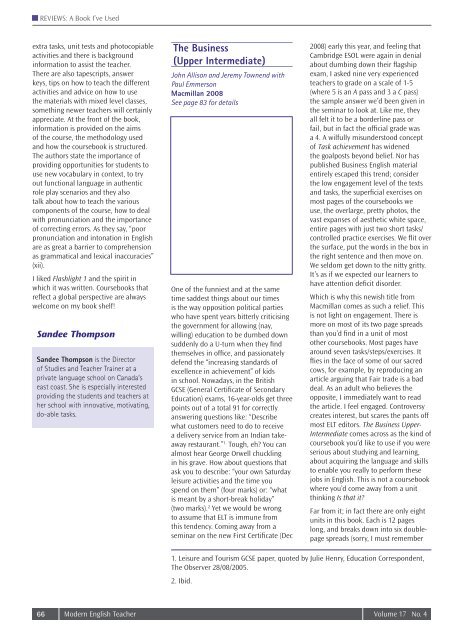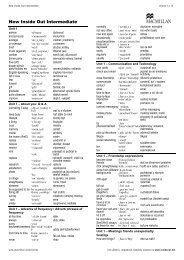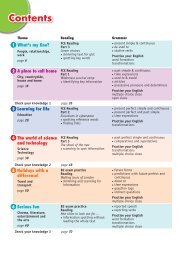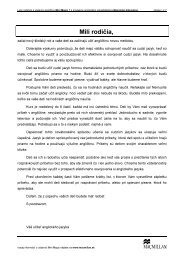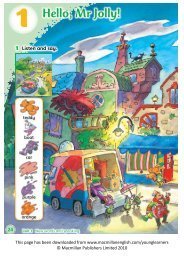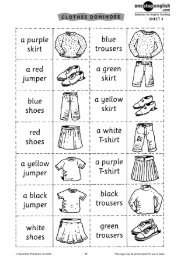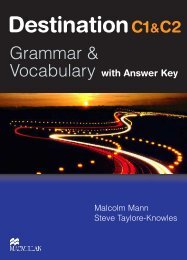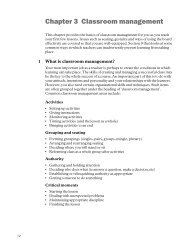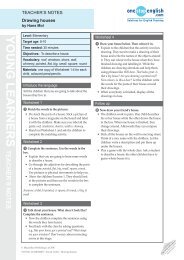The Business (Upper Intermediate) - Macmillan Education
The Business (Upper Intermediate) - Macmillan Education
The Business (Upper Intermediate) - Macmillan Education
Create successful ePaper yourself
Turn your PDF publications into a flip-book with our unique Google optimized e-Paper software.
REVIEWS: A Book I’ve Used<br />
extra tasks, unit tests and photocopiable<br />
activities and there is background<br />
information to assist the teacher.<br />
<strong>The</strong>re are also tapescripts, answer<br />
keys, tips on how to teach the different<br />
activities and advice on how to use<br />
the materials with mixed level classes,<br />
something newer teachers will certainly<br />
appreciate. At the front of the book,<br />
information is provided on the aims<br />
of the course, the methodology used<br />
and how the coursebook is structured.<br />
<strong>The</strong> authors state the importance of<br />
providing opportunities for students to<br />
use new vocabulary in context, to try<br />
out functional language in authentic<br />
role play scenarios and they also<br />
talk about how to teach the various<br />
components of the course, how to deal<br />
with pronunciation and the importance<br />
of correcting errors. As they say, “poor<br />
pronunciation and intonation in English<br />
are as great a barrier to comprehension<br />
as grammatical and lexical inaccuracies”<br />
(xii).<br />
I liked Flashlight 1 and the spirit in<br />
which it was written. Coursebooks that<br />
reflect a global perspective are always<br />
welcome on my book shelf!<br />
Sandee Thompson<br />
Sandee Thompson is the Director<br />
of Studies and Teacher Trainer at a<br />
private language school on Canada’s<br />
east coast. She is especially interested<br />
providing the students and teachers at<br />
her school with innovative, motivating,<br />
do-able tasks.<br />
<strong>The</strong> <strong>Business</strong><br />
(<strong>Upper</strong> <strong>Intermediate</strong>)<br />
John Allison and Jeremy Townend with<br />
Paul Emmerson<br />
<strong>Macmillan</strong> 2008<br />
See page 83 for details<br />
One of the funniest and at the same<br />
time saddest things about our times<br />
is the way opposition political parties<br />
who have spent years bitterly criticising<br />
the government for allowing (nay,<br />
willing) education to be dumbed down<br />
suddenly do a U-turn when they find<br />
themselves in office, and passionately<br />
defend the “increasing standards of<br />
excellence in achievement” of kids<br />
in school. Nowadays, in the British<br />
GCSE (General Certificate of Secondary<br />
<strong>Education</strong>) exams, 16-year-olds get three<br />
points out of a total 91 for correctly<br />
answering questions like: “Describe<br />
what customers need to do to receive<br />
a delivery service from an Indian takeaway<br />
restaurant.” 1. Tough, eh You can<br />
almost hear George Orwell chuckling<br />
in his grave. How about questions that<br />
ask you to describe: “your own Saturday<br />
leisure activities and the time you<br />
spend on them” (four marks) or: “what<br />
is meant by a short-break holiday”<br />
(two marks). 2 Yet we would be wrong<br />
to assume that ELT is immune from<br />
this tendency. Coming away from a<br />
seminar on the new First Certificate (Dec<br />
2008) early this year, and feeling that<br />
Cambridge ESOL were again in denial<br />
about dumbing down their flagship<br />
exam, I asked nine very experienced<br />
teachers to grade on a scale of 1-5<br />
(where 5 is an A pass and 3 a C pass)<br />
the sample answer we’d been given in<br />
the seminar to look at. Like me, they<br />
all felt it to be a borderline pass or<br />
fail, but in fact the official grade was<br />
a 4. A wilfully misunderstood concept<br />
of Task achievement has widened<br />
the goalposts beyond belief. Nor has<br />
published <strong>Business</strong> English material<br />
entirely escaped this trend; consider<br />
the low engagement level of the texts<br />
and tasks, the superficial exercises on<br />
most pages of the coursebooks we<br />
use, the overlarge, pretty photos, the<br />
vast expanses of aesthetic white space,<br />
entire pages with just two short tasks/<br />
controlled practice exercises. We flit over<br />
the surface, put the words in the box in<br />
the right sentence and then move on.<br />
We seldom get down to the nitty gritty.<br />
It’s as if we expected our learners to<br />
have attention deficit disorder.<br />
Which is why this newish title from<br />
<strong>Macmillan</strong> comes as such a relief. This<br />
is not light on engagement. <strong>The</strong>re is<br />
more on most of its two page spreads<br />
than you’d find in a unit of most<br />
other coursebooks. Most pages have<br />
around seven tasks/steps/exercises. It<br />
flies in the face of some of our sacred<br />
cows, for example, by reproducing an<br />
article arguing that Fair trade is a bad<br />
deal. As an adult who believes the<br />
opposite, I immediately want to read<br />
the article. I feel engaged. Controversy<br />
creates interest, but scares the pants off<br />
most ELT editors. <strong>The</strong> <strong>Business</strong> <strong>Upper</strong>-<br />
<strong>Intermediate</strong> comes across as the kind of<br />
coursebook you’d like to use if you were<br />
serious about studying and learning,<br />
about acquiring the language and skills<br />
to enable you really to perform these<br />
jobs in English. This is not a coursebook<br />
where you’d come away from a unit<br />
thinking Is that it<br />
Far from it; in fact there are only eight<br />
units in this book. Each is 12 pages<br />
long, and breaks down into six doublepage<br />
spreads (sorry, I must remember<br />
1. Leisure and Tourism GCSE paper, quoted by Julie Henry, <strong>Education</strong> Correspondent,<br />
<strong>The</strong> Observer 28/08/2005.<br />
2. Ibid.<br />
66 Modern English Teacher Volume 17 No. 4
REVIEWS: A Book I’ve Used<br />
“<br />
<strong>The</strong> <strong>Business</strong> <strong>Upper</strong>-<strong>Intermediate</strong> comes<br />
across as the kind of coursebook you’d like to<br />
use if you were serious about studying and<br />
learning, about acquiring the language and<br />
skills to enable you really to perform these jobs<br />
in English.<br />
”<br />
that my readership went through the<br />
educational system when it was a bit<br />
more demanding) on: About <strong>Business</strong>,<br />
with information and language for<br />
the topic area (talk, text, listen, talk,<br />
sort of thing) including a rather long<br />
reading text, though at least these<br />
texts are not from the same media<br />
source; Vocabulary (plenty of input<br />
and plenty of chances to use it, more<br />
listening, more short texts); Grammar<br />
and Functions (eight to ten steps or<br />
activities); Speaking (again, eight to<br />
ten tasks); Writing (ditto), with some<br />
excellent building stages and ideas; and<br />
finally a Multi-skill case study. “Where’s<br />
the listening” you say. It’s everywhere;<br />
every two-page spread has at least<br />
one listening activity. <strong>The</strong>re are two<br />
densely-packed review pages after every<br />
two units. If you were to do it all, it<br />
would be a heck of a lot to get through;<br />
I did a quick reckoning that a unit<br />
could easily keep you going through<br />
36 hours of class time, and that’s<br />
without factoring in the huge amount<br />
of material on the DVD-ROM, which is<br />
included with the Student’s Book, the<br />
two pages of controlled Grammar and<br />
Practice exercises at the back of the<br />
Student’s Book, the 3-4 extra activities<br />
per unit in the same place, or indeed<br />
the additional photocopiable material<br />
at the back of the Teacher’s Book.<br />
A flimsy package it ain’t. <strong>The</strong> only<br />
thing that strikes me as being missing<br />
here is some kind of attention to the<br />
phonological system of the language,<br />
aka pronunciation, surely as likely to<br />
interfere with communication of the<br />
message as hit-or-miss grammar or<br />
imprecise lexis.<br />
Looking a bit more closely at the<br />
spreads in the Student’s Book, it has<br />
things that you probably won’t have<br />
come across elsewhere; where most<br />
<strong>Business</strong> English coursebooks settle<br />
for microscopic factoids to break the<br />
monotony of the very wide margins,<br />
<strong>The</strong> <strong>Business</strong> offers an Internet Research<br />
Task on every spread, and the Grammar<br />
pages have a concise language box<br />
called Refresh Your Memory, which<br />
also points you to Grammar and<br />
Practice pages at the back of the book.<br />
Potentially difficult or peripheral items<br />
of lexis that appear in texts are printed<br />
in grey and appear in the Glossary in<br />
alphabetical order per unit and are<br />
colour coded by the section where they<br />
occur first in the book. This careful<br />
attention to detail is for me a hallmark<br />
of <strong>The</strong> <strong>Business</strong>.<br />
Another aspect in which I think <strong>The</strong><br />
<strong>Business</strong> has got it right is in the<br />
consciously international feel. You’ll<br />
find more references to Africa, Asia and<br />
Latin America here than in just about<br />
every other <strong>Business</strong> English coursebook<br />
combined. It’s a very attractive artefact<br />
in visual terms too; despite having a<br />
large amount of material on each page,<br />
it doesn’t come across as cluttered at all.<br />
<strong>The</strong> photos and other artwork are well<br />
selected and not suspiciously large. <strong>The</strong><br />
design team – those people who have<br />
a huge influence on the final feel of a<br />
book but who are seldom acknowledged<br />
by the end users – deserve high praise<br />
for their work on <strong>The</strong> <strong>Business</strong>.<br />
Frustratingly though, the class CD<br />
doesn’t tell you what unit or task<br />
you’re on, just Tapescript 23, etc. More<br />
seriously, and this issue is by no means<br />
limited to this title, but when I dipped<br />
into Unit 5 (Selling more) and was doing<br />
the Listening on page 64, you know the<br />
sort of thing:<br />
‘Listen to the three conversations<br />
between sales representatives and their<br />
customers. Decide which salesperson<br />
makes each of the following mistakes:<br />
a) criticizing the competition;<br />
b) giving in to pressure;<br />
c) overreacting and threatening the<br />
customers.’<br />
I found that the class had a fairly<br />
obvious obstacle to overcome, i.e. What<br />
are the three short dialogues about<br />
Yes, we know the roles, we know the<br />
overall communicative purpose of the<br />
interaction, and we know that the sales<br />
rep is going to make a hash of it in one<br />
of the three ways, but we don’t know<br />
what he/she is trying to sell, which is<br />
obviously going to have an impact on<br />
just about everything, including the<br />
choice of lexis. This lack of context is<br />
what the learner struggles with first, and<br />
it gets in the way of trying to answer<br />
the questions. As I say, this failing is<br />
widespread. How can we get round it<br />
Maybe by having a lead-in task that<br />
establishes that in dialogue 1 someone<br />
is trying to sell an expensive swimming<br />
pool to a private individual, in the<br />
second an IT program that costs $32,000<br />
(though why both the rep and the buyer<br />
are Brits when talking dollars is a bit<br />
strange), and in the third someone is<br />
being badgered into joining a health/<br />
fitness club (the kind of thing we<br />
once – in the days before they played<br />
“… careful attention to detail is for me a<br />
hallmark of <strong>The</strong> <strong>Business</strong>.<br />
”<br />
Volume 17 No. 4 www.onlineMET.com 67
REVIEWS: A Book I’ve Used<br />
“… there is so much going for <strong>The</strong> <strong>Business</strong><br />
that I wish I’d had it a year ago when I was<br />
choosing a coursebook for a group of young,<br />
intelligent business students …<br />
”<br />
thumping pop/rock – called a gym).<br />
Alternatively, we could simply tell the<br />
students what the context is. Gosh.<br />
No Workbook Well, you’d hardly<br />
need one, but there is a DVD-ROM<br />
with a huge amount of short – and<br />
entertaining – authentic video material<br />
helpfully handled with a vast range of<br />
tasks. What else is on the DVD-ROM:<br />
the class audio, tests, model business<br />
documents, a grammar reference,<br />
downloadable docs, as well as problemsolving<br />
games. <strong>The</strong> Teacher’s Book,<br />
apart from all the things you’d expect,<br />
gives you a generous 23 pages of<br />
additional material, as well as a Subject<br />
Background introduction at the start of<br />
every unit. Thorough or what<br />
<strong>The</strong> Contents page in the Student’s Book<br />
could hardly be clearer, and the unit<br />
headings are nicely transparent, but<br />
here is one thing I feel the editors have<br />
short-changed us on; if I’m looking for<br />
something on, say, Telephoning, or<br />
apologizing for a mix-up with an order<br />
or an arrangement, I have no way of<br />
finding it. But this is small carping;<br />
there is so much going for <strong>The</strong> <strong>Business</strong><br />
that I wish I’d had it a year ago when I<br />
was choosing a coursebook for a group<br />
of young, intelligent business students,<br />
surely the ideal market for <strong>The</strong> <strong>Business</strong>,<br />
learners who are keen to achieve a little<br />
more in their careers than those young<br />
Britons doing the Health and Social care<br />
GCSE who the government thinks will be<br />
sufficiently challenged by tasks that ask<br />
them to identify: “two different family<br />
relationships”.<br />
Brian Brennan<br />
Brian Brennan is the Language<br />
Training Manager at International<br />
House Barcelona Company Training.<br />
<strong>Business</strong> Start Up 1<br />
Mark Ibbotson and Bryan Stephens<br />
Cambridge University Press 2006<br />
See page 83 for details<br />
<strong>The</strong> development process of textbooks<br />
takes so long nowadays that it wasn’t<br />
until I noticed a mention of my name<br />
at the back of this book that I realised it<br />
was the same book that I had reviewed<br />
pre-publication quite a few years ago.<br />
I remember telling people to look out<br />
for it every time they complained about<br />
the lack of a really low-level business<br />
English course. However, so much time<br />
has passed that I completely forgot<br />
about it and started making those<br />
complaints myself.<br />
So, is <strong>Business</strong> Start Up 1 worth the<br />
wait Simply put, yes. It fills exactly<br />
that gap we have been moaning about<br />
as it is useable with even complete<br />
beginners, but with enough emphasis<br />
on interesting and natural language<br />
and communication that elementary<br />
students would also learn a lot. While<br />
the course isn’t perfect, those factors<br />
alone make it stand out.<br />
<strong>Business</strong> Start Up 1 has 12 units taking<br />
students from saying “Hello” and the<br />
alphabet in Welcome to discussing<br />
sales and orders in Sales. Each unit<br />
is divided into three double-paged<br />
spreads, like Exchanging information<br />
by email, Making telephone calls and<br />
Talking about the weather and climate<br />
for Unit 9 Communication. As you can<br />
see from these titles, the authors haven’t<br />
neglected the general English that lower<br />
68 Modern English Teacher Volume 17 No. 4


